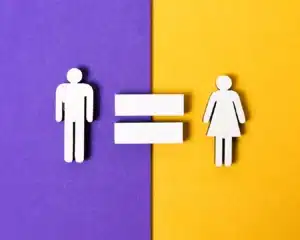The Journey Towards Gender Equality: Progress and Challenges
Equality between men and women is one of the human rights that individuals have fought for for many years.
Gender equality is the reality of equal ease to resources and opportunities, ranging from economic participation and decision-making power and it is also the value of different behaviors aspirations as well as needs regardless of gender.
The path to gender equality has been a tortuous one, but it is the gender journeys that we have made in recent decades that have been the most significant.
The status of women in this field has improved on several fronts through education, employment, and political representation. Despite such, there is a lot that has yet to be done to achieve equal gender.
It can not be denied that gender equality is important. It is fundamental to human rights and it is important for economic development, social progress, and peace.
The path toward gender equality has taken a lot of years, and it hasn’t been smooth, but progress has been achieved in recent decades. There is yet much more work that needs to be done to complete the track.
Today, we live in a world that is characterized by globalization where the gender role of women has moved to center stage and been actively contributing to all spheres of society.
Progress Over Time
Here are some milestones and achievements in the progress toward gender equality:
- Education

– In the past 50 years, the number of girls enrolled in primary school has increased from 52% to 90%.
– In 2020, women made up 57% of all college students in the United States.
– In 2021, women made up 49% of all science and engineering degree recipients in the United States. - Workplace

– In 1963, the Equal Pay Act was passed, which made it illegal to pay women less than men for doing the same job.
– In 1972, Title IX of the Education Amendments was passed, which prohibited sex discrimination in any educational institution that receives federal funding.
– In 1993, the Family and Medical Leave Act was passed, which allows employees to take unpaid leave for family or medical reasons.
– In 2010, the Lilly Ledbetter Fair Pay Act was passed, which made it easier for women to sue for pay discrimination.
– In 2021, the number of women in the workforce reached an all-time high of 57%. - Legal Rights

– In 1920, the 19th Amendment to the U.S. Constitution was ratified, which gave women the right to vote.
– In 1967, the Supreme Court ruled in Loving v. Virginia that laws prohibiting interracial marriage were unconstitutional.
– In 1973, the Supreme Court ruled in Roe v. Wade that women have a constitutional right to abortion.
– In 1994, the Violence Against Women Act was passed, which provided funding for programs to prevent and respond to domestic violence, sexual assault, and stalking.
– In 2013, the Supreme Court ruled in United States v. Windsor that the Defense of Marriage Act (DOMA), which defined marriage as between one man and one woman, was unconstitutional.
– In 2015, the Supreme Court ruled in Obergefell v. Hodges that same-sex couples have the constitutional right to marry. - Societal Attitudes

– In the past 50 years, there has been a significant shift in societal attitudes towards gender equality.
– A 2021 Pew Research Center survey found that 72% of Americans believe that women should have the same rights and opportunities as men.
– A 2022 Gallup poll found that 83% of Americans believe that women should be able to work outside the home.
There are different strategies through which we can achieve gender equality. We have written a detailed article on the subject, that you may like to read: Championing Gender Equality: Impactful Strategies from Around the World
Empowering Women in Education
Education can empower women in many ways, including:
- Improving women’s health: Education can lead to fewer unintended pregnancies and delayed marriage. Educated women are also more likely to be informed about nutrition and healthcare.
- Increasing employment opportunities: Educated women are more likely to participate in the formal labor market and earn higher incomes.
- Decreasing poverty: Education can decrease women’s poverty and has a greater impact on poverty and development than men’s education.
- Improving child health: Educated women are more likely to have healthier children. Education is also one of the most influential factors in reducing infant mortality rates.
- Challenging discrimination: Educated women can become agents of change, challenging discriminatory practices and attitudes within their families and communities.
- Inspiring future generations: Educated women can inspire future generations.
- Improving maternal mortality rates: Education contributes to lower maternal mortality rates.
- Education can also help women:
– Make informed choices and advocate for themselves
– Participate in civic and political activities
– Foster their leadership potential
– Invest in their children’s education
Some initiatives to promote girls’ education include:
Beti Bachao Beti Padhao Scheme: Launched in 2015, this scheme aims to promote the education of the girl child and change people’s mindset towards the girl child.
Breaking Glass Ceilings in the Workplace
About gender equality in terms of employment, there has been significant progress but women have not yet made the running in leadership positions and pay alike.

- Notable Achievements:
– More women, however, are cracking the ‘glass ceiling’ and making it to the top leadership roles. Examples in the limelight are Barra, Mary of GM, Fraser Jane of Citigroup, and Fortune 500’s Rosalind Brewer.
– The Equal Pay Act and anti-discrimination laws, as examples of legal protections, offer remedies for such inequities.
– More diversity training and mentorship will open up paths for women.
Legal Reforms and Policy Changes
Legal reforms and policy changes can impact society by addressing structural issues and redistributing resources.
They can also lead to changes in social, economic, and political systems.
Here are some examples of legislative efforts promoting gender equality:
- Protection of Women from Domestic Violence Act, 2005
- Commission of Sati (Prevention) Act, 1987
- Sexual Harassment of Women at Workplace (Prevention, Prohibition and Redressal) Act, 2013
- Immoral Traffic Prevention Act, 1956
- Equal Remuneration Act, 1976
- Hindu Marriage Act of 1955

Law reform is the process of examining existing laws and advocating and implementing change in a legal system. Law reform can also ensure that civil society can provide input into public policy decision-making.
Some recommendations to enhance the effectiveness of legal reforms include:
- Fostering political stability and commitment
- Increasing public awareness and participation
- Promoting the rule of law and anti-corruption measures
- Addressing socioeconomic inequality
As the world is shifting towards AI. Let’s read how The AI tool ensures gender equality
The Role of Men in Gender Equality
The inclusion of men in the gender equality discussion is critical for achieving real gender parity. The male gender has historically been considered the dominant one and has in most cases enjoyed more powers and privilege over women. It makes them partly responsible for generating and leveraging their power and privilege to promote a more equitable world.
There are more good examples to mention here. There are a lot of positive instances showing men to enjoy gender equality.
- Emma Watson’s HeForShe campaign He For She Movement is a worldwide campaign that seeks to empower men and boys to speak up for gender equality.

- The United Nations MenEngage network efforts try to involve men and boys in the battle for gender equality.

- The Promundo Institute is an international body formed to ensure gender equality and social justice across the world.
Challenges in Achieving Gender Equality
Gender equality is a human right guaranteed by society; it should be incorporated into society if the nation has to live in a just and equal environment.
While numerous challenges need to be overcome if gender equality is to be fully attained, the global AIDS-free generation initiative has helped in mitigating the major challenges associated with HIV/AIDS.
Cultural resistance is one of the biggest challenges, because of the persistence of stereotypes and outdated traditions.
Such norms and stereotypes are often patronizing to women and deprive them of opportunities in all spheres of life: education, employment, political life, and issues of health.
Another weakness is the aversion to change, which normally is born from those who benefit from such a situation.
This resistance can come in various shapes and forms, from open discrimination to more covert means of exclusion.
To overcome these hurdles, it is essential to have a kind of consistent and coherent approach from all sectors of the society.
Governments, as well as businesses and even civil society organizations, should play key roles in the promotion of gender equality.
Education, public awareness programs, and the idealization of role models can help people to quit their habits.
- Identify the causes of inequality due to gender
This includes dealing with problems like the problem of poverty, the problem of inequality, and violence against women. - Empower women and girls
This can be achieved by allowing them to learn, earn, and take care of their health. - Women should be present in all sectors of decision-making
This is critical in ensuring that women’s views are captured and their needs are incorporated.
Looking Ahead: Future Steps
Last but not least, one should be updated and active in building gender equality.
Units are supposed to be informed about the challenges that women and girls face, and support. We can also use our voices as a means of ending gender injustice and making the call for change.
Through cooperation, the world can have a perfect society where every woman and girl would be given equal opportunity to realize their full abilities.
Ready to make a positive impact in the world?
UPDEED is the place for you. Our free and open platform is filled with inspiring stories from individuals and organizations who are making a difference in their communities and beyond. Connect and collaborate with like-minded individuals from around the globe on UPDEED, and discover your own potential to create meaningful change. Join our community and make a difference.





